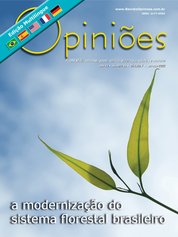Benone Magalhães Braga
Gerente Executivo da Aperam BioEnergia
OpCP69
A chave está em nossas mãos!
Esta edição da Revista Opiniões Florestal traz uma pauta real e relevante para o negócio florestal nacional. A modernização do sistema florestal brasileiro é debatida e explorada em qualquer ambiente estabelecido do setor, seja ele acadêmico, empresarial, de negócios, e assim por diante. Inegáveis foram os avanços alcançados em mecanização e modernização das atividades florestais nas últimas décadas, mas ainda existem áreas e operações que carecem de um movimento mais contundente nesse sentido.
 Ao refletir diante de tal realidade, inevitavelmente retorno nove anos atrás, quando ingressei no setor florestal. Engenheiro mecânico de formação e egresso do setor siderúrgico – de onde muitas das tecnologias, processos e equipamentos são trazidos prontos e formatados do estrangeiro –, me deparei com um setor pujante cuja evolução e patamar de então, se sustentavam em iniciativas e projetos muitas das vezes desenvolvidos localmente, por representantes da esfera florestal nacional.
Ao refletir diante de tal realidade, inevitavelmente retorno nove anos atrás, quando ingressei no setor florestal. Engenheiro mecânico de formação e egresso do setor siderúrgico – de onde muitas das tecnologias, processos e equipamentos são trazidos prontos e formatados do estrangeiro –, me deparei com um setor pujante cuja evolução e patamar de então, se sustentavam em iniciativas e projetos muitas das vezes desenvolvidos localmente, por representantes da esfera florestal nacional. Exemplificando, mas não se limitando a eles, o progresso em melhoramento e variabilidade genética que hoje abastece a produtividade e sanidade da nossa produção florestal é oriundo de estudos e esforços conduzidos por agentes locais do setor florestal (Exemplo: clone AEC-0043, primeiro clone comercial de Corymbia do Brasil).
A mecanização e modernização de atividades de silvicultura e colheita como conhecemos hoje só foi possível graças a ações e adaptações conduzidas por players também do setor florestal brasileiro (Exemplo: desgalhador florestal, com reais ganhos em produtividade e segurança). A vanguarda mundial em tecnologias de alta produtividade e rendimento para conversão da madeira em carvão vegetal só aconteceu por termos vocação inovadora e a imperativa necessidade de trilhar esse caminho, já que não há produção de carvão vegetal no mundo que se compare à brasileira (Exemplo: Forno FAP-2000, primeiro e maior forno retangular copa plana do mundo).
Diante dessa reflexão e constatação, fica claro que a chave do potencial transformador necessário para se fecharem as lacunas em modernização e mecanização ainda presentes no sistema florestal brasileiro está nos principais atores desse mesmo setor.
E qual seria a chave para destravar todo esse potencial transformador?
Bom, diversas são as possibilidades, mas ouso aqui listar três chaves nas quais enxergo, particularmente, grande potencial:
1) Atuação multilateral entre representantes do setor florestal (academia/produtores/fornecedores), num esforço conjunto para diagnosticar as necessidades comuns, que carregam consigo um maior potencial de impacto, bem como para direcionar as ações e recursos que se propõem a solucionar essas necessidades identificadas;
2) Iniciativas de Inovação Aberta que exponham vácuos tecnológicos, não somente para os agentes que já navegam no ambiente florestal rotineiramente, mas também para indivíduos e organizações externas, que trazem consigo não apenas muita tecnologia, mas também uma visão nova do problema, completamente livre de vieses. Já vemos hoje movimentos nesse sentido (Exemplo: Forest Insight - SIF, Radar - IPEF, etc.), que, com o tempo, certamente desencadearão o fluxo de muitas soluções transformadoras para a indústria florestal;
3) Programas internos que fomentam, investem, premiam e destravam o potencial inovador que existe dentro de cada organização ou instituição, afinal, qualquer uma delas é formada por pessoas, e pessoas que conhecem como ninguém os problemas do dia a dia, por sempre se depararem com eles e, justamente por isso, carregam consigo todo o ferramental necessário para endereçar uma solução prática e viável. Como diria o poeta, os melhores problemas para serem resolvidos são os problemas de sempre!
Certamente as três possibilidades mencionadas anteriormente, acompanhadas de outras ações que também se propõem a atender ao mesmo objetivo, carregam consigo suficiente energia para tirar da inércia e movimentar as forças necessárias à resolução de qualquer problema e/ou lacuna existente em nossas florestas.
Concluindo, pondero e proponho a todos vocês, caros leitores, um verdadeiro call to action. Enquanto setor, como estamos encontrando consensos e canalizando esforços e recursos nas iniciativas que irão, de alguma maneira, elevar o patamar de modernização e, consequentemente, o patamar de competitividade e sustentabilidade da indústria florestal como um todo? Enquanto organização, o quão abertos estamos a modernas correntes de inovação externas, muitas das vezes não ortodoxas, que carregam consigo grande potencial transformador? Enquanto indivíduos, o quão dispostos estamos a tomar nosso papel de protagonista da mudança e carregar a chave que vai abrir e modificar completamente os horizontes de modernização da indústria florestal brasileira nos próximos anos?
Realmente, a chave está em nossas mãos!




